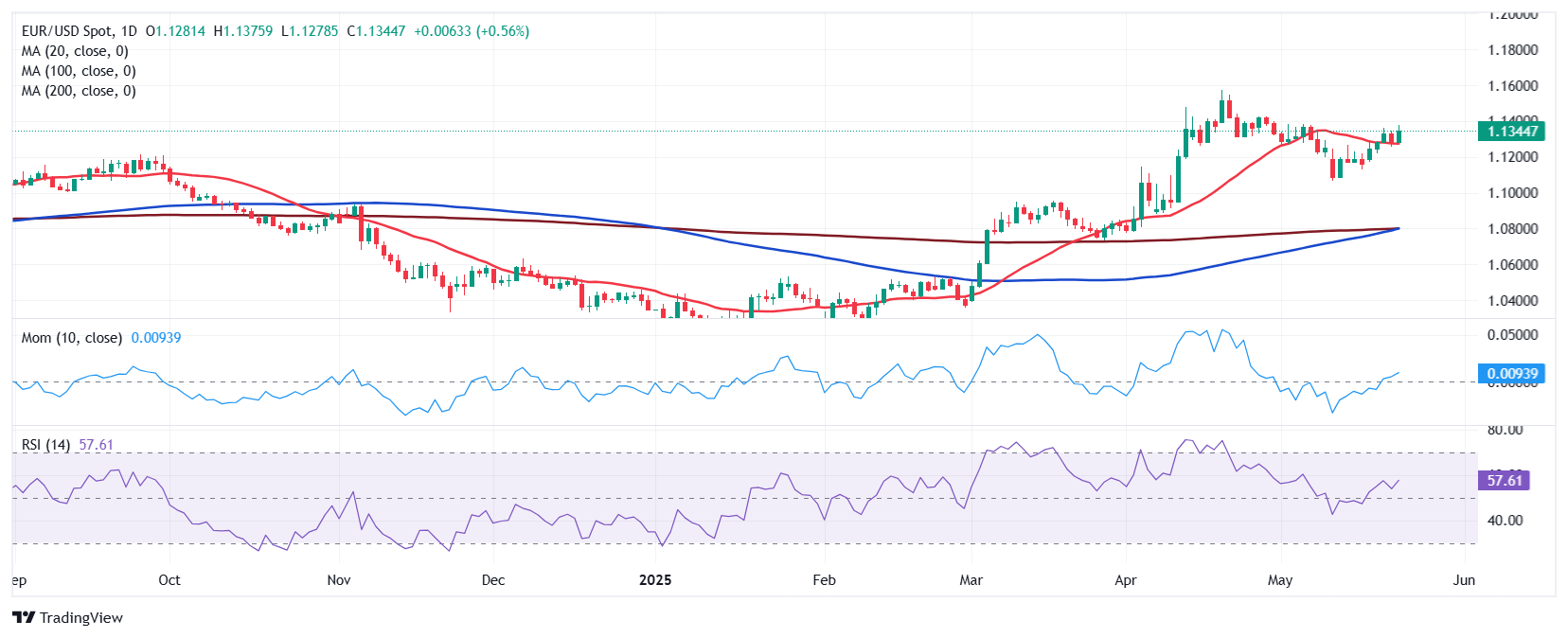- US President Donald Trump’s trade war and tax cut bill fueled concerns about economic health.
- European business output shrank more than anticipated in May, limiting EUR gains.
- EUR/USD resumes its long-term bullish run, with higher highs in sight.
The EUR/USD pair trades near a weekly high of 1.1365 ahead of the close, as the US Dollar (USD) remains pressured by political and fiscal headlines. The Euro (EUR) surged on broad USD dumping, but tepid local data limited the advance.
Trade war and tax bill
Trade tensions somehow returned amid the lack of progress in negotiations and fresh tensions between the United States (US) and China. Both countries agreed on a 90-day truce and reduced massive retaliatory tariffs a couple of weeks ago, boosting the market’s optimism. However, things deteriorated after the US issued an industry warning against using Chinese chips, targeting the Asian giant Huawei. By the end of the week, Washington and Beijing agreed to maintain communication, but optimism among investors faded.
Tensions also arose between the US and Japan, as the latter is unwilling to fulfil US demands. Furthermore, the Japanese government made it clear that there is no use for an agreement unless Washington eliminates tariffs, particularly a 25% levy on autos and car parts. Talks seem to have stalled after Japan’s top trade negotiator Ryosei Akazawa noted Japan will not rush to seal a trade deal if that puts the country’s interests at risk.
Adding fuel to the fire, Trump pledged a straight 50% tariffs on European Union (EU) imports starting June 1st. Through a Truth Social post on Friday, Trump claimed trade talks with the EU are going nowhere, and once again repeated that the sole purpose of the European Union was “to take advantage of the US on trade.”
But it’s not all about the trade war. US President Donald Trump is now focused on his ‘One Big Beautiful Bill Act’, a major bill aimed at reshuffling taxes and government spending. Tax cuts within the bill for individuals and corporations are expected to increase the country’s outstanding debt by between $3 and $5 billion, fueling concerns about the US economic health. The bill passed the House of Representatives on Thursday by a slim margin and now moves to the Senate, which will discuss it in the upcoming days.
Data played against EUR/USD advance
S&P Global and the Hamburg Commercial Bank (HCOB) released the preliminary estimates of the May Purchasing Managers’ Index (PMI) for both economies. The surveys showed a steeper downturn in European businesses as new orders continued to decrease. A sharp contraction in services output led the way lower, with the German index falling to 47.2, a 30-month low from the previous 49, and the Eurozone (EU) one posting 48.9, down from 50.1 in April. A modest uptick in manufacturing was not enough to compensate for the slide, resulting in the EU Composite PMI shrinking to 49.5 from the previous 50.4.
US figures, on the other hand, were upbeat. Manufacturing output improved to 52.3 from 50.2 in April, while the Services PMI rose to 52.3 from 50.8 in the same period. As a result, the Composite PMI surged to 52.1 after posting 50.6 in April, a two-month high. Still, the figures were just enough to help EUR/USD correct lower before it resumed its advance.
Finally, Germany released the IFO Survey, showing a modest uptick in Business Climate, up to 87.5 in May from the 86.9 posted in April. Expectations improved to 88.9, although the assessment of the current situation missed expectations and printed at 86.1.
Additionally, European Central Bank (ECB) President Christine Lagarde hit the wires on Friday and warned international trade will be “changed forever” by trade-related tensions triggered by the US decision to impose tariffs on most major trading partners.
“Warned that international trade will be changed forever by the tensions over tariffs,” Lagarde added, before noting countries need to question the links of dependency they have with each other and with the US.
The macroeconomic calendar will include some interesting events in the upcoming days. The US Federal Open Market Committee (FOMC) will release the Minutes of the latest meeting on Wednesday, while a revision of the US Q1 Gross Domestic Product (GDP) will be out on Thursday.
The focus will shift to Germany on Friday, as the country will release April Retail Sales and the preliminary estimate of the May Harmonized Index of Consumer Prices (HICP). Also on Friday, the US will publish April Personal Consumption Expenditures (PCE) Price Index figures, the Federal Reserve’s (Fed) favorite inflation gauge.
EUR/USD technical outlook
From a technical point of view, the risk skews to the upside. The weekly chart for the EUR/USD pair shows it reversed its losing streak and resumed its advance after correcting overbought conditions. The pair trades well above all its moving averages, with a firmly bullish 20 Simple Moving Average (SMA) crossing above directionless and converging 100 and 200 SMAs, all gathering around 1.0830. Technical indicators, in the meantime, turned neutral to marginally bullish well above their midlines, suggesting higher highs are likely in the upcoming days.
The EUR/USD pair is neutral-to-bullish according to technical readings in the daily chart. The pair broke above a now flat 20 SMA at around 1.1270, which attracted buyers for three days in a row. At the same time, the 100 SMA is about to cross above the 200 SMA, far below the short one, still supporting an upward run. Finally, the Momentum indicator hovers directionless around its midline, while the Relative Strength Index (RSI) indicator aims north at around 57, resuming its advance.
A break through the weekly high exposes the 1.1460 price zone, while the next relevant level to watch is the year high at 1.1573. Below the 1.1270 area, on the other hand, the pair has room to fall towards the 1.1160 region, while below the latter, the next relevant support level is May’s low at 1.1064.

Tariffs FAQs
Tariffs are customs duties levied on certain merchandise imports or a category of products. Tariffs are designed to help local producers and manufacturers be more competitive in the market by providing a price advantage over similar goods that can be imported. Tariffs are widely used as tools of protectionism, along with trade barriers and import quotas.
Although tariffs and taxes both generate government revenue to fund public goods and services, they have several distinctions. Tariffs are prepaid at the port of entry, while taxes are paid at the time of purchase. Taxes are imposed on individual taxpayers and businesses, while tariffs are paid by importers.
There are two schools of thought among economists regarding the usage of tariffs. While some argue that tariffs are necessary to protect domestic industries and address trade imbalances, others see them as a harmful tool that could potentially drive prices higher over the long term and lead to a damaging trade war by encouraging tit-for-tat tariffs.
During the run-up to the presidential election in November 2024, Donald Trump made it clear that he intends to use tariffs to support the US economy and American producers. In 2024, Mexico, China and Canada accounted for 42% of total US imports. In this period, Mexico stood out as the top exporter with $466.6 billion, according to the US Census Bureau. Hence, Trump wants to focus on these three nations when imposing tariffs. He also plans to use the revenue generated through tariffs to lower personal income taxes.

